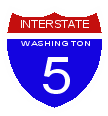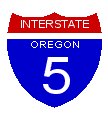 The
Traffic King of the West
The
Traffic King of the West
Interstate
5 is the main north-south traffic artery in Washington and Oregon. The
majority of Washington and Oregon citizens live near I-5. As the main route
between the major cities of the west coast, its economic importance cannot
be underestimated.
The precursor to I-5 was US 99, also known as the Pacific Highway and in Washington state as Primary State Highway 1. Travel on 99 was slow, particulary in Washington where travel between Seattle and Portland, OR could take the better part of a day. The mostly 2-lane road wound through small towns and the scenic countryside. Good for the leisurely Sunday drive, but not for commerce. Straightening of the highway in Washington began in the 1930's with the highway being relocated between Fife and Boeing Field through the areas now known as Federal Way and Sea-Tac, WA. Previously the road went up the Puyallup, White, and Green river valleys, running to the north of Puyallup and to the west of Sumner, Auburn, Kent, and Renton (this is today's Valley Avenue and West Valley Highway). Chuckanut Drive in Whatcom County was also bypassed about this time, the former being redesignated US 99A and later, with the 1964 highway renumbering, as SR 11. Beginning in the early 1950's the state began a massive straightening of US 99 by constructing completely new sections of four lane limited access highway between Vancouver and Olympia, relocating the Nisqually River crossing with a four lane structure on a new alignment, and widening the highway between the Nisqually River and Tacoma, and a new 4-lane section between Everett and Mount Vernon.
In the 1950's the Washington State Department of Highways was beginning to plan a system of expressways. A key part of this plan was the proposed Tacoma / Seattle / Everett expressway, which was proposed as a toll facility prior to the passage of the Interstate Highway Act in 1956. This proposed freeway became part of Interstate 5 when the act was signed into law. Sections of freeway were already under construction in Vancouver, Olympia, and Mount Vernon. These secions also became part of I-5. In Seattle, the state removed US 99 from city streets by constructing the Alaskan Way Viaduct in stages between 1956 and 1959. An additional reroute of US 99 occurred in the early 1960's when a new First Avenue South Bridge and freeway were built on the west bank of the Duwaumish (Green) River in Seattle's industrial south end.
Construction of I-5 in Washington was completed in 1981 when the last section opened in Kelso. Major reconstruction projects occurred in the 1980's in Vancouver and Olympia to widen the freeway from four lanes to eight and modernize the interchanges. US 99 was decommissioned in Washington in the late 1960's.
Today I-5 from the Canadian Border to Mount vernon is a four lane facility. There are several low clearance overpasses on the section through Mount Vernon. Just south of Mount Vernon the freeway increases to six lanes with a wide median (this section was completed in the early 1970's). Just north of Marysville the freeway goes to eight lanes of general traffic and remains that way through Tumwater, except in Seattle, where the express lanes add 2-4 reversible lanes between Northgate and downtown (where the freeway narrows to 4 lanes briefly), and Tukwila, where it's 10 and briefly 13 lanes wide. Between Tumwater and the Toutle River the freeway remains virtually unchanged from when it was built in the early 1950's. It's four lanes wide, and the traffic can be heavy. Incidentally the speed limit on this section is 70 MPH. At the Toutle River the freeway widens to six, then eight lanes. Between Kalama and Woodland the Burlington Northern / Santa Fe and Union Pacific railroad tracks are in the freeway median.
I-5 crosses the Columbia River on two drawbridges which open periodically to allow ships to pass. In 1994 a barge struck the southbound bridge, knocking it out of commission for two weeks. This resulted in snarled traffic during rush hour (I was living in Vancouver at the time).
In Oregon, to my knowledge, US 99, 99E, and 99W remained unchanged from the time they were commissioned to the construction of I-5. Construction of I-5 in Oregon was complete by the late 1960's. A major reconstruction project took place at the interchange with I-84 in the early 1990's. US 99, 99E, and 99W were decommissioned in the late 1980's. I-5 between the Columbia River and Salem is for the most part eight lanes wide. Between Salem and the Oregon / California border it is for the most part four lanes wide.
Traffic on I-5 in the Puget Sound area is among the worst in the nation. This is due to the area's geography and highway planning history (Seattle voters overturned a comprehensive transportation plan in a 1970 referendum.) Traffic jams are common, particularly in the afternoons. Traffic on I-5 heading into Seattle from the north in the afternoons every day of the week usually moves no faster than 5-10 MPH.
The links on the left take you to my pictures and more information on the freeway.